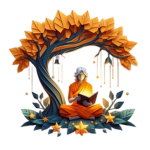The Kurma Purana possesses deep metaphysical concepts that lay down the ground for Hindu philosophy; thus this ancient text renders in-depth guiding principles on the nature of reality, consciousness, and the divine, which remains pertinent for the spiritual seekers of today.
Cosmic Creation and Divine Origin
Creation is manifested in a cycle according to the Kurma Purana, rather than a single isolated event. In the text, endless cycles of creation, preservation, and dissolution happen in the universe. Between Chapter 1, verses 12-15, is the description of Lord Vishnu, now in the form of a turtle, who, through and during the churning of the cosmic ocean (samudra manthan), supported Mount Mandara; this symbolizes the idea that divine consciousness undergirds the material universe.
According to the Purana, the ultimate reality, Brahman, manifests as the trimūrti to create these three cosmic cycles of creation, preservation, and destruction-Brahma (creator)-to preserve through Vishnu and to destroy through Shiva. In Chapter 4, verses 23-27, it describes the manner by which the formless Brahman takes forms to interact with creation while remaining eternally unchanged in essence.
Self-Nature (Atman)
One of the greatest teachings talked about in the Kurma Purana is the nature of the self. In Chapter 12, verses 255-259, it describes how the individuality jīvātman essentially shares identity with the universal consciousness Brahman, though seemingly different due to māyā (cosmic illusion).
The text states: "Just as the sun appears to be many when reflected in different vessels of water, so does the eternal Atman appear as many separate beings" (Kurma Purana, Chapter 12, verse 257). This illustrates the concept of non-duality (advaita) that lies at the heart of Hindu metaphysics.
Karma and Dharma
The Kurma Purana provides a matured view of karma (law of cause and effect) and dharma (cosmic order and duty). Karma is summarized in Chapter 29, verses 11-19, as how every action creates reactions, which build an individual's experience in the present and future through life and death.
Moreover, this text makes an important distinction between actions taken out of desire (sakāma karma) and actions done as a duty without any wish for a personal reward (niṣkāma karma). The text states that liberation (moksha) is therefore not to be sought by abandoning all actions, but by remaining unattached to their results, as stated in Chapter 30, verses 45-48: "The wise perform action without attachment, surrendering the fruits to the Divine."
Four Purusartas
To the Kurma Purana, pursuance of the four human goals-puruṣārthas, dharma (righteousness), artha (prosperity), kāma (pleasure), and moksha (liberation)-is stated. It, in Chapter 28, verses 3-9, emphasizes pursuing these goals in a harmonious way and with the right proportion toward one's spiritual evolution.
Liberation (moksha) is endorsed to be the highest goal that is indeed described in Chapter 33, verses 72-76 as the realization of the true nature of the self as being eternal, conscious, and blissful (sat-chit-ānanda).
Maya and the Nature of Reality
The Kurma Purana looks at the question of māyā, which is often rendered as cosmic illusion. Chapter 24, verses 19-25, states that the material universe does not exist in a truly unreal state; it has a condition of reality-existence while it is experienced in a limited way, not in eternal reference as does Brahman.

.png)
0 Comments